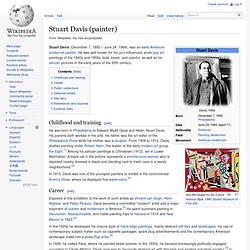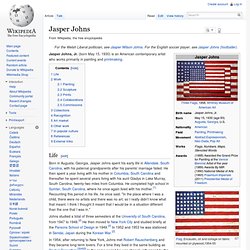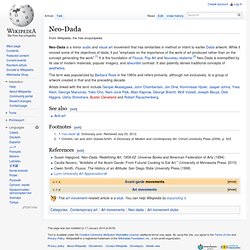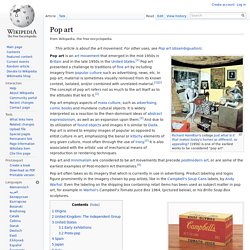

Roy Lichtenstein. Roy Fox Lichtenstein (pronounced /ˈlɪktənˌstaɪn/; October 27, 1923 – September 29, 1997) was an American pop artist.

During the 1960s, along with Andy Warhol, Jasper Johns, and James Rosenquist among others, he became a leading figure in the new art movement. His work defined the basic premise of pop art through parody.[2] Favoring the comic strip as his main inspiration, Lichtenstein produced hard-edged, precise compositions that documented while it parodied often in a tongue-in-cheek humorous manner. His work was heavily influenced by both popular advertising and the comic book style. He described pop art as "not 'American' painting but actually industrial painting".[3] His paintings were exhibited at the Leo Castelli Gallery in New York City. Whaam! Early years[edit] Career[edit] Cap de Barcelona, sculpture, mixed media, Barcelona Lichtenstein entered the graduate program at Ohio State and was hired as an art instructor, a post he held on and off for the next ten years. Later work[edit] Stuart Davis. Stuart Davis (December 7, 1892 – June 24, 1964), was an early American modernist painter.

He was well known for his jazz-influenced, proto pop art paintings of the 1940s and 1950s, bold, brash, and colorful, as well as his ashcan pictures in the early years of the 20th century. He was born in Philadelphia to Edward Wyatt Davis and Helen Stuart Davis. His parents both worked in the arts. His father was the art editor of the Philadelphia Press while his mother was a sculptor. From 1909 to 1912, Davis studied painting under Robert Henri, the leader of the early modern art group the Eight.[1] Among his ashcan paintings is Chinatown (1912), set in Lower Manhattan.
In 1913, Davis was one of the youngest painters to exhibit in the controversial Armory Show, where he displayed five watercolors.[3] In 1928, he visited Paris, where he painted street scenes. He was represented by Edith Gregor Halpert at the Downtown Gallery in New York City. Jasper Johns. Detail of Flag (1954-55).

Museum of Modern Art, New York City. This image illustrates Johns' early technique of painting with thick, dripping encaustic over a collage made from found materials such as newspaper. This rough method of construction is rarely visible in photographic reproductions of his work. Jasper Johns, Jr. (born May 15, 1930) is an American contemporary artist who works primarily in painting and printmaking. Life[edit] Neo-Dada. Neo-Dada is a minor audio and visual art movement that has similarities in method or intent to earlier Dada artwork.

While it revived some of the objectives of dada, it put "emphasis on the importance of the work of art produced rather than on the concept generating the work".[1] It is the foundation of Fluxus, Pop Art and Nouveau réalisme.[2] Neo-Dada is exemplified by its use of modern materials, popular imagery, and absurdist contrast. It also patently denies traditional concepts of aesthetics. The term was popularized by Barbara Rose in the 1960s and refers primarily, although not exclusively, to a group of artwork created in that and the preceding decade. See also[edit] Andy Warhol. Andy Warhol (/ˈwɔrhɒl/;[1] August 6, 1928 – February 22, 1987) was an American artist who was a leading figure in the visual art movement known as pop art.

His works explore the relationship between artistic expression, celebrity culture and advertisement that flourished by the 1960s. After a successful career as a commercial illustrator, Warhol became a renowned and sometimes controversial artist. The Andy Warhol Museum in his native city, Pittsburgh, Pennsylvania, holds an extensive permanent collection of art and archives. It is the largest museum in the United States dedicated to a single artist. Warhol's art encompassed many forms of media, including hand drawing, painting, printmaking, photography, silk screening, sculpture, film, and music. Early life (1928–1949) In third grade, Warhol had Sydenham's chorea (also known as St.
As a teenager, Warhol graduated from Schenley High School in 1945. 1950s 1960s Campbell's Soup I (1968) Attempted murder (1968) 1970s 1980s. Pop art. Pop art is an art movement that emerged in the mid-1950s in Britain and in the late 1950s in the United States.[1] Pop art presented a challenge to traditions of fine art by including imagery from popular culture such as advertising, news, etc.

In pop art, material is sometimes visually removed from its known context, isolated, and/or combined with unrelated material.[1][2] The concept of pop art refers not as much to the art itself as to the attitudes that led to it.[2] Pop art employs aspects of mass culture, such as advertising, comic books and mundane cultural objects. It is widely interpreted as a reaction to the then-dominant ideas of abstract expressionism, as well as an expansion upon them.[3] And due to its utilization of found objects and images it is similar to Dada.